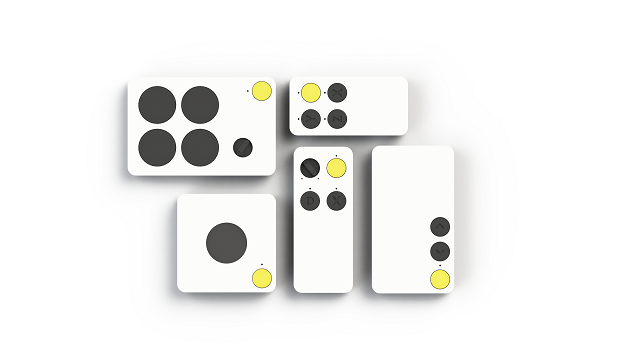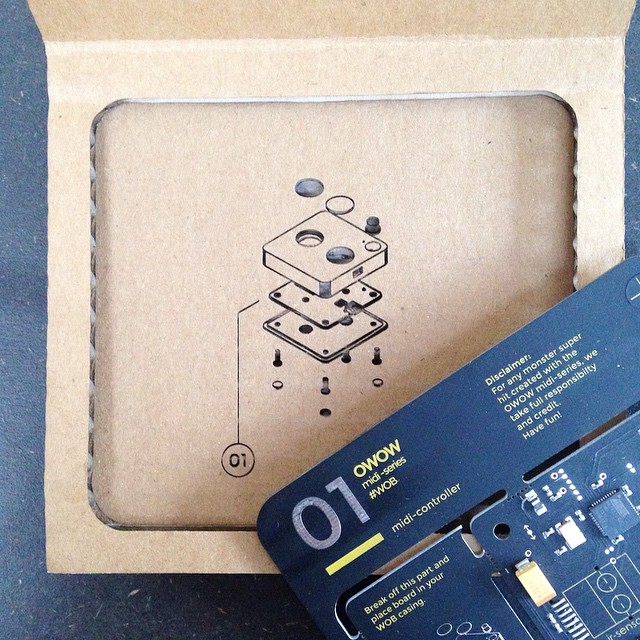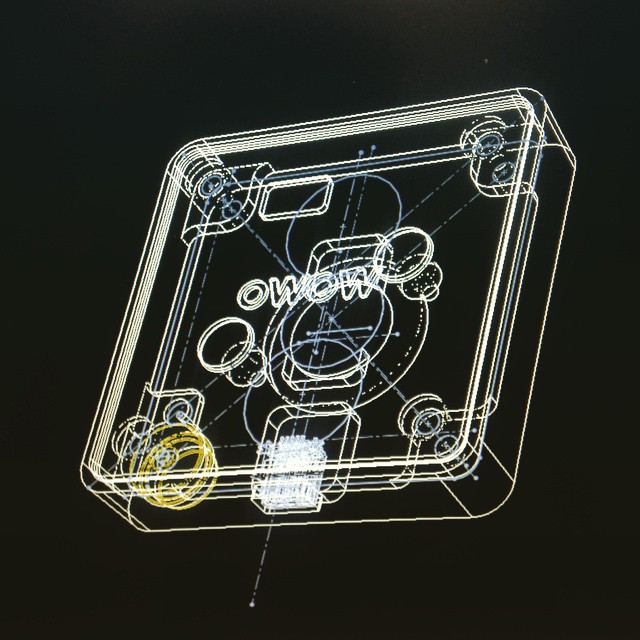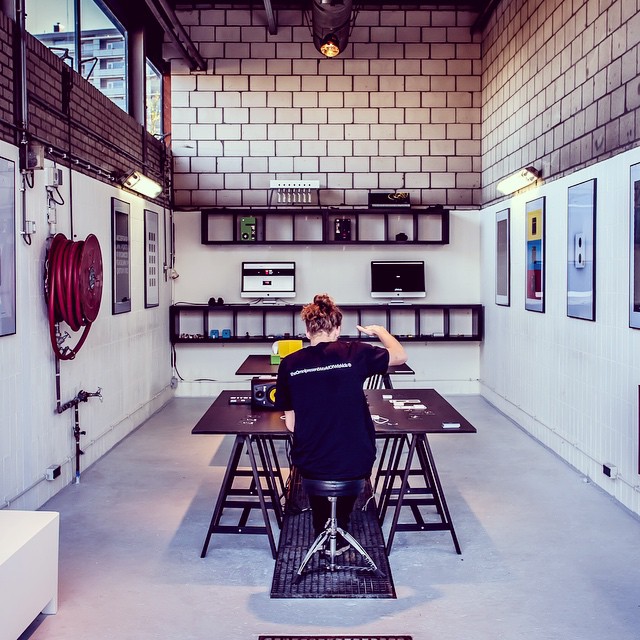“Instead of going to music school, I studied design.”
Wiggle, wob, drum, pads, and scan are new gestural instruments that seek to cut the distance between an idea, making a move with your body, and a sound. Think you could draw a doodle that expresses a sound? Wish you could just air-drum in that percussion line? Easier to wave your hand to describe a noise? These modular components let you do just that.
OWOW, the startup behind it, is nearing a funding goal on Kickstarter – but it’s not quite there, five days until the deadline. So now is the perfect time to go behind the scenes. Not satisfied with that demo video? We’ve got our own resident contributing design expert to head to the source and investigate – completing today’s three-part look at cutting-edge Dutch design startups from the town of Eindhoven.
From the edge of the Netherlands’ slick design scene, industrial designer and music technologist Arvid Jense joins CDM for a series of interviews with Eindhoven Music Startups.
Eindhoven music startups: OWOW
Pieter Jan Pieters is the founder of OWOW, the Omnipresent World Of Wizkids. After graduating Design Acadamy Eindhoven with the Sound On Intuition project (in which he explored movement and musical computer control) and an internship at Teenage Engineering, he’s starting to make his way with things like the Social Project and Booty Drum. Aiming to earn their marks as an independent design studio, OWOW is bringing out a new breed of intuitive MIDI controllers in early spring through Kickstarter. The first series will be brought out in credit-card and product format with an estimated price of €50 and €80. After this series, the same form-factor is planned to be extended for analog modules and digital effect. See their instagram for more pictures and videos.
How did you come to make your product?
Everything started two years ago, when I graduated Design Academy Eindhoven where I made a series of musical instruments for which the goal was that they could be played intuitively, without the need for learning theory. A lot of people are making music with computer right now, so rather than translating an acoustic instrument like the piano to control the computer, I wanted to make instruments to play the computer. This resulted in a series of instruments, on which for instance, if you’d want a wavy sound, you could make wavy movements. If you’d tap your finger on the table, you’d trigger a sound. If you bend you finger you would bend a sound. You won’t have to learn any new movements, but you can use what you already know.
[vimeo width=”640″ height=”360″]https://vimeo.com/49239380[/vimeo]
After graduation, I did a lot of projects for costumers. And now we’re working hard on our own products and are making good progress. Goal is to make a lot of small instruments. For instance our first product will be wob, which is a plug and play distance MIDI controller. There are similar products, but they are very DIY, you’ll have to build and program everything yourself, which is a huge leap for people who don’t understand those kind of things. But I wanted to give the magic of those DIY tools to everyone. Plug and play; your movements just create sounds.
We started making the wob with a high grade aluminum casing to make the product a beautiful as possible. But we’ve noticed that the product would become much more expensive. But as we wanted to keep the price low, we’ve chosen to make two variations: the full product with casing and just the bare circuit board in credit card format. This is still a high grade product, but we strip everything to its essence. You’ll get a 3d print file with it, so you can still print the casing if you want. For the young dudes want just the thing that matters, for the lowest price.
A lot of our friends who have been making a lot of music and who are touring, are constantly trying to bring their home studio. But it is difficult to take everything because a lot of instruments are heavy and take a lot of space. So we though the credit card format would not only look cool, but could be very practical when you have a wallet with six or seven different instruments in it. We want to have one product/form with a lot of different possibilities.
After the wob we’ll make a whole range of devices. For instance the wiggle, which changes sounds when you move it around its axes. The scan is an analog piano roll, with which you can scannotes you draw on pian. The drum triggers sounds by moving it in the air. And the pads has four drum pads or hot keys. These five are the first series which will come in the credit card format.
Why are you doing this?
This started from me being frustrated that everybody was saying that you need to be able to read music to be able to make music. I could play the drums, but not read music. I just want to make computer music more fun. But it started from a personal interest: this is what I would think is really cool. And apparently there are a lot of people who think similarly and are agreeing with my vision.
How will your instrument change music?
With DAW’s you work in sequencers where you draw in perfectly timed notes, but whether I do it or you do it, it will always sound the same. Already a lot of people start to deliberately shuffle or just-out-of-swing their notes to make everything sound more live. Our products will help bring more personality into the music, because the physical input is always just out-of tempo. Goal is that it will become more personal, with more feeling and more fun! That you’re not just sitting in front of your computer, but that you’re moving and playing. You won’t need to wear a robot suit or have to make huge movements, because the CRD’s and DVC’sare simple and direct.
[youtube width=”640″ height=”360″]https://www.youtube.com/watch?v=CH9ZaghtL2E[/youtube]
What do you think design thinking brings to electronic instruments?
If you look at companies like apple, everything looks very slick, even at electronics level. I learned a lot at my internship at Teenage Engineering, because they have a lot of attention to details. So as the product started to go towards just being a bare circuit board, we focused on make just that visually very powerful. It can be both functional and beautiful. Together with Alex, our engineer, we’ve sat down to make the board. Not just to put a graphic on it, but to design it from the start. So then you’ll get things like the finger print at the wiggle, which doubles as an on/off switch. It could’ve just been a switch, but by bringing the functional and aesthetic together, exciting new solution arise.
I’m more focused on users, while engineers are focused on technology. Engineers like to make things more and more complex, while I like to keep things brutishly simple. A guitar is basically a bunch of strings you’re hitting. A drum is just a tensioned skin. A piano is just a key you’re pushing. It’s the simplicity of those instruments which make the musicians creative. The restrictions force you to explore all the ways in which you can use it. All the different options of electronic instruments make them so complex, that people will just choose for the basic settings, losing their resourcefulness. Our products just have one or two functions, that’s it; very specific little instruments, which allow you to explore your own creativity.
The design approach allows you to not always be forced to look for the latest and best technology, but to use those things which are available to the fullest. Some very simple sensors have a lot of possibilities which never have been explored. If you’re technology focused, you might want to develop your own sensors, but we want to check what is possible with this device. We are not the ones adding terms like ‘gesture controls’, while we know that doesn’t work musically. Our thing is stupid.
What are your future plans?
We will start production, grab all the money and start living on Hawaii. No, but seriously, after the first five, we will take a good look at which ones we’d want to make next. We’d like to bring out new ones regularly. Say every few months or half year there could be a new instrument. We want to bring our instruments to everyone, so we would like to see our instruments at every music store all over the world.
We have a number of musicians who we have given our products to use in their studios. We ask them to play and test them and give us feedback. Sometimes this will result in us adding functionality. One user basically hacked the wob, to be able to triggers sounds just by moving his hand over the device. After checking with other musicians, we added this. So by playing with the instrument, the functionality will develop. We discover new things. We might think something is cool, but only when we see people really using it, we discover the real value. We only put things on it which will be used. For instance, we were measuring the angle of your hand above the wob as an extra effect. But once we made it, we discovered it didn’t work for the users. It might have cost us two weeks, but if it doesn’t work like we want it to, we just remove it. So only playing and testing will get the product we want. You might have ten ideas, but eight of them might not work at all, but you’ll only discover that when you actually build it.
Why do you choose to be independent? How do you deal with investors?
I did not want investors, because then the projects will be about money, and that is not our main interest. We work for costumers for which we do apps, websites or advertisement campaigns. This funds our own work. The CRD series will be the pinnacle of our work on which we have had to give zero concessions, it is purely ours. We’ve extended our release date a few times, just because we thought we could still make it better. But if we would have had investors, there would quickly have been pressure of them to see a return on their investment. This product has to be completely ours, so we can stand on our own feet. We want to be a rebel who can do whatever he wants.
Is your product Open-Source?
We doubt in how far we want to go open-source. We are making our casing files public so you can print them by yourself, but in code we are looking not to make everything public, but to give possibilities for making a different version. We want to find a balance. We sned to be able to live from this and avoid blatant copy-cats. We’re not making our products for DIYers, but we do want to create possibilities of the people wanting to tweak.
How is Eindhoven for you?
In a way we just stuck around here, as we went to school in this city. But Eindhoven is very good for giving people the space they need, like our studio here (Sectie C, gathering place for a lot of art and design companies). We were considering moving to Antwerp or Amsterdam, but Eindhoven is not bad at all. There is a lot of technological development and while the city doesn’t directly sponsor us, they do create good locations. We are right in between Antwerp and Amsterdam. Maybe because there is no that much to do in Eindhoven, we start working harder; there is a lot of distraction in the big cities and we might just spend our time in café’s and concert halls, here is just our work.
While we have a super musician we collaborate with in Eindhoven, others are for instance in London. So it doesn’t really matter where you are, in this age you can be anywhere in no time. If you want to meet to someone, you can just take the plane. We would pay four times as much for our space in a big city, while I’d rather spend that money on development.
There are not that many other musical instrument companies in the Netherlands thoguh, a few guitar pedal builders maybe. There is a lot of electronic music history in Eindhoven, but not much remains. There are a lot of DIY synthesizer builders, but I am not aware of anything major going on. But what I notice is that those people working on music products really do their own thing. Maybe in a few years a number of those will get successful and it might seem everything comes from here.
What is the future of music?
Everything will become more expressive. Things have been very serious, but now things will become more playful. In the past some guys just picked up some guitars and a drum kit and just hit it to create something cool. While now people are inside their computer, making music like a programmer. And I think a lot of companies are trying to bring back fun and playfulness. I’m not sure if it will happen, but that is what I want it to turn into. And if people, think it’s cool, we’ll get a stream of people, and otherwise we might have to wait some years.





